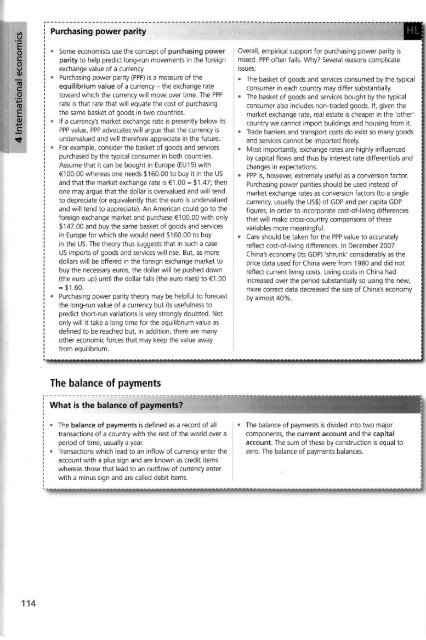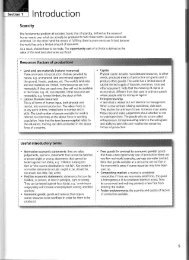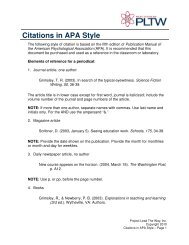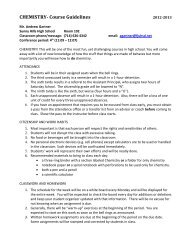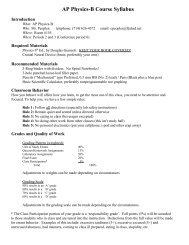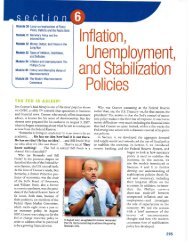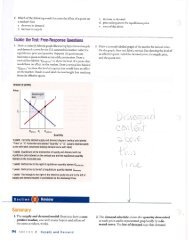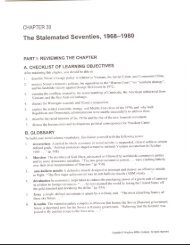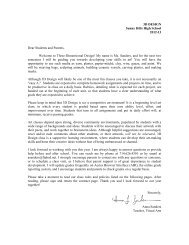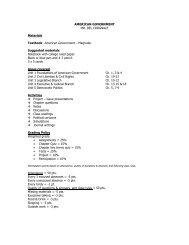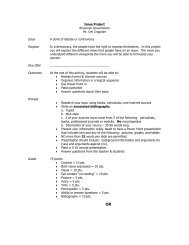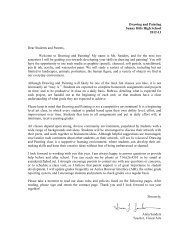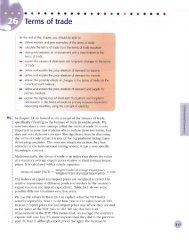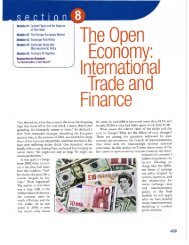IB Econ Study Guide Internationals - Sunny Hills High School
IB Econ Study Guide Internationals - Sunny Hills High School
IB Econ Study Guide Internationals - Sunny Hills High School
Create successful ePaper yourself
Turn your PDF publications into a flip-book with our unique Google optimized e-Paper software.
114<br />
Purchasing power parity<br />
. Some economists use the concept of purchasing power Overall, empiricai support for purchasing power parity ls<br />
parity to help predict long-run movements in the foreign mixed. PPP often fails. Why? Several reasons complicate<br />
exchange value of a currency.<br />
issues:<br />
. Purchasing power parity (PPP) is a measure of the<br />
equilibrium value of a currency - the exchange rate<br />
toward which the currency will move over time. The PPP<br />
rate is that rate that will equate the cost of purchasing<br />
the same basket of goods in two countries.<br />
lf a currencyb market exchange rate is presently below its<br />
PPP value, PPP advocates will argue that the currency ls<br />
undervalued and will therefore aooreciate in the future.<br />
For example, consider the basket of goods and services<br />
purchased by the typical consumer in both countries.<br />
Assume that it can be bought in Europe (EU15) with<br />
The basket of goods and services consumed by the typical<br />
consumer in each country may differ substantially.<br />
The basket of goods and services bought by the typical<br />
consumer also includes non-traded goods. lf, given the<br />
market exchange rate, real estate is cheaper in the'other'<br />
country we cannot import buildings and housing from it.<br />
Trade barriers and transport costs do exist so many goods<br />
and services cannot be imported freely.<br />
Most importantly, exchange rates are highly influenced<br />
by capital flows and thus by interest rate differentials and<br />
rh:nno< rn avno.trii^n<<br />
€100.00 whereas one needs $ 160.00 to buy it in the US<br />
and that the market exchange rate is €1 .00 = $1.47; then<br />
PPP is, howevet extremely useful as a conversion factor<br />
Purchasing power parities should be used instead of<br />
one may argue that the dollar is overvalued and will tend<br />
to depreciate (or equivalently that the euro is undervalued<br />
and willtend to appreciate). An American could go to the<br />
foreign exchange market and purchase €100.00 with only<br />
$147.00 and buy the same basket of goods and services<br />
market exchange rates as conversion factors (to a single<br />
currency, usually the US$) of cDP and per capita GDP<br />
figures, in order to incorporate cost-of-livrng differences<br />
that will make cross-country comparisons of these<br />
variables more meaningful.<br />
in Europe for which she would need $ 160.00 to buy<br />
in the US. The theory thus suggests that in such a case<br />
US imports of goods and services will rise. But, as more<br />
Care should be taken for the PPP value to accurately<br />
reflect cost-of-living differences. In December 2007<br />
China's economy (its GDP)'shrunk' considerably as the<br />
dollars will be offered in the foreign exchange market to<br />
buy the necessary euros, the dollar will be pushed down<br />
(the euro up) until the dollar falls (the euro r ses) to €1 .00<br />
= $1.60.<br />
Purchasing power parity theory may be helpful to forecast<br />
the long-run value of a currency but its usefulness to<br />
predict short-run variat ons is very strongly doubted. Not<br />
only will it take a long tlme for the equilibrium value as<br />
defined to be reached but, in addition, there are many<br />
other economic forces that may keep the value away<br />
from equilibrium.<br />
price data used for China were from 1980 and did not<br />
reflect current living costs. Living costs in China had<br />
increased over the period substantially so using the new<br />
more correct data decreased the size of Chinas economy<br />
lly almost 40%.<br />
The balance of payments<br />
What is the balance of<br />
The balance of payments is defined as a record of all<br />
transactions of a country with the rest of the worid over a<br />
period of time, usually a year.<br />
Transactions which lead to an inflow of currency enter the<br />
account with a plus sign and are known as credit items<br />
whereas those that lead to an outflow of currency enter<br />
with a minus sign and are called debit items.<br />
The balance of payments is divided into two major<br />
components, the current account and the capital<br />
account. The sum of these by construction is equal to<br />
zero. The balance of oavments baiances.


